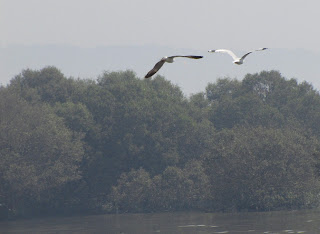The presence of a long coast line, mangrove swamps in some locations and salubrious climate, Mumbai has attracted some species of migratory birds during winter months from November to March. The birds return to their original habitat during summer months. The cycle goes on. For the past few years, there were reports on destruction of mangroves at Sewri due to discharge of solid pollutants and liquid effluents, lessening the number of bird arrivals. It was my endeavor to spot the birds at Sewri mangroves in present scenario and photo shoot the same. I had four visits to Sewri in months of February and March of 2012. The experience has been varied, some rewarding and yet some disappointing ones.
While surfing web to get some prior information on watching
birds at Sewri, some interesting points surfaced. Apart from the months when
these migratory birds swamp the mudflats, the tide timings for both low and
high, play a significant role. Some info said, one should visit the site during
low tide. Some said to visit between 2 hours before and two hour after high
tide. One even recommended to visit the site one hour after the high tide.
Finding tide timings in Mumbai was no
big deal. And, I was ready for my first visit. It is worth while recounting it
for wanna be bird watchers for whatever information provided in following photo
essay.
5th February 2012
Sunday morning being convenient time for me for this photo
shoot, I set out around 10.30 am, good half an hour after the high tide. Being
my exploratory visit, I just carried my Sony Handycam. I reached near rail
station Sewri west in about 15 minutes, crossed over via over-bridge to arrive
on the eastern side. A twenty minutes walk brought me to the Sewry jetty. The
jetty is a small one with a large ship on right hand side in grounded condition
and a number small abandoned fishing vessels in different states of
degradation, on the left side, entrenched in mud. A few low resolution shots of
Sewri jetty from frames of the video clips is as follows.

There are mangroves on either side on the mudflat, large
area of mud and slush during the low tide. With water collected in pockets Small
crabs and insects were visible poking in and out of the slush. The sea water
mass was some 50 ft distance on left side. The mangrove all dark green and gray
covered a huge area as far as eyes could go. The extreme backdrop, visible
through haze had a few multi-storied structures, the factory structure and
chimney.
In the immediate vicinity, the mudflats having some water pockets with high tide water receding, a dozon of brown coloured Black Tailed Godwit birds were moving around poking their enormously long beaks rhythmically into shallow water for their feed.
I climbed through the cement stepped path going up the slope, came to the dargah and took a left turn to arrive at the Fort.
12th February 2012
When we visited the Sewri in in the morning, it was low tide
time – water receded to show us the mudflats up to a very long distance. The
Flamingos could be viewed faintly at a very long distance. Visitors who carried
binoculars were trying to see the birds with a slight advantage. I missed
taking any video footage however I caught an unknown bird in my digicam on the
nearby mud flat.
19th February 2012
I arrived at Sewri around 11.15 am, about half an hour after
the high tide time. I straight away made it to the Sewri Fort.
The sea water just receding - a large part of mudflats were
still inundated. The Flamingos on this day much nearer into the shallow waters
of the sea. Zooming to extent possible, I found, a large group of the same was
bobbing on the water. The footage proved to be good subsequently, when I
created the video. A low resolution frame of the scene crafted out of the
video clip is given below.
As time wore on, the Flamingos were moving slowly towards
the shore in an orderly fashion. I wanted to have a close view of the birds but
decided against going towards the jetty, instead I was trying to figure out how
to go to near mangroves at the bottom of the fort, towards the left side. After
some inquiry, I took a right turn after coming on the road and another right
turn brought me near the mangroves. Caught a couple of Gulls in flight.
The new place brought newer experience of watching some
Flamingo like birds with brown feather on the mudflat.
A group of Red Billed Gulls on
shallow water near the ware house, jutting into the sea was interesting. It was
a novel experience of watching the Gulls settling on water in group, looking
for their feed and restlessly scratching different parts of their body and all
of a sudden taking off in unison.
4.3.2012
We reached the Sewri jeety, one hour after the high tide
time around 10 am, but was surprised to see that water had receded much more
than I had expected. The Gulls and Flamingo groups were visible at a long
distance, while on the mudflats in isolated pockets of collected water, it was
opportune moment to capture Black Tailed Godwit birds in
a group of a dozen or so. I got down a few feet from paved jetty to land on
mudflat for some close shots. Since they were not too far, I had some still
images as well. These species of birds have long beaks and constantly poke at
the bottom of the collected water pools to collect their feeds.
……………………………………………………………………………………






















No comments:
Post a Comment